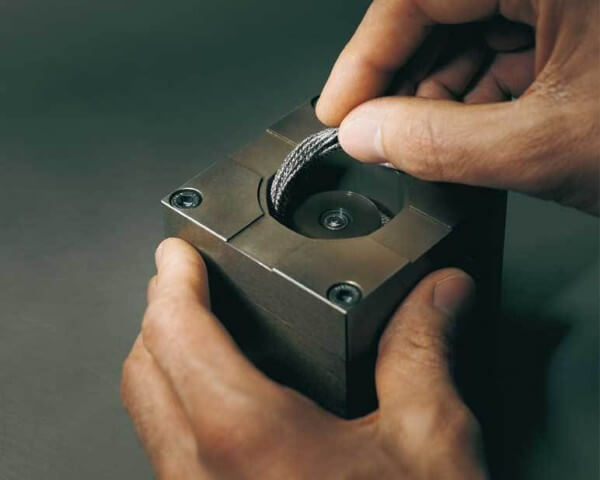It has become a fashion among watchmakers to explore the possibilities of materials out of the range of the traditional brass, steel, ruby and the like. When it comes to components such as wheels and escapement parts, silicon is all the rage. Carbon fibre is another material which many now favour. Used mainly in aerospace for its high rigidity and very light weight, watchmakers appreciate it for the same reasons, and for its decorative high-tech look. Twenty-five years ago, the first bicycles made from carbon-fibre reinforced tubes caused a sensation. Their lightness was one part of the appeal. Another was the high-tech style of the shimmering coal-black microfibres that could be seen with each ray of light reflected by the surface of the tube.
Carbon fibres are produced using a process known as pyrolysis to produce individual fibres with a natural diameter of 5 to 8 microns. A bunch of 70 fibres has the thickness of a human hair. Pure fibres consist of long chains of carbon molecules, the same atoms which, in different atomic grids, can form graphite or diamonds. These fibres are characterized by high tensile strength, elasticity, electric conductivity, low density and an almost negligible thermal coefficient; they are also non-magnetic.

Complex technology for watchmaking purposes
How do we go from an ultra-thin, soft, elastic fibre to the kind of large surfaces needed for an aeroplane wing? For industrial use, the single fibres are threaded into thicker filaments that can then be woven into the fabrics that give carbon fibre surfaces their characteristic look. The hardness of the final material, a carbon composite, is achieved by soaking the fibres with an epoxy resin and hardening the composite material. Nowadays, the individual fibres are delivered with a thin resin coating already in place, so that once the layers of carbon fabric have been laminated, the percentage of carbon fibre is much higher than the percentage of resin.
Manufacturing carbon-fibre dials is a relatively simple process as it involves using thin sheets of pre-laminated and hardened carbon-fibre fabric. In contrast, manufacturing mainplates and cases, as Audemars Piguet does, requires complex technology that has to be mastered in-house.
An innovative process
Mainplates for the Millenary MC12 and the all-new Royal Oak Concept Watch are machined from a sheet of carbon composite that has been custom-made to AP’s specifications. The fibres inside this composite are not woven but arranged at random and varying in length to guarantee stability in all directions. “Milling the surfaces on CNC machines to create high-precision recesses for the components is a difficult job,” explains Christoph Guhl, in charge of Audemars Piguet’s technical communication. “As with titanium or platinum, the pieces tend to become very hot and ruin the tools by sticking to them. It’s a task that requires very specific expertise.” This explains why the CNC machines consume more cooling liquid than usual, and why the tools have a diamond surface.
In contrast, Audemars Piguet’s carbon-fibre cases are produced using a completely innovative procedure known as forging. Pre-coated, threaded carbon fibre filaments of two different lengths are packed into moulds made from top-quality stainless steel. The material is then compressed at high temperature and pressure into a solid form. Any surplus epoxy is liquefied and oozes out of the moulds. This increases the amount of carbon fibre to an incredible 74%. The end result is pitch black with a satin-like surface. Because the cases and bezels are moulded to a high degree of precision, they require very little machining after the forging process. The finished case is exceptionally rigid and resistant, but also extremely light. A Royal Oak Offshore “Alinghi Team” chronograph with a forged carbon-fibre case and bezel weighs just 94 grams compared with 245 grams for a steel Royal Oak Offshore of the same size.




















